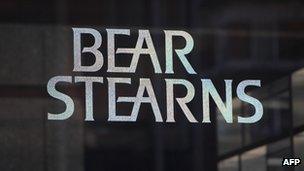JP Morgan’s sub-prime horror
- Published
- comments

There are two jaw-dropping elements to the case brought Monday night against JP Morgan by the attorney general of the state of New York. First is the estimate that investors incurred $22.5bn of losses on $87bn of bonds made out of low-quality mortgages and sold to them in 2006 and 2007 alone.
Second is the disclosure of a manic and frenzied culture of procuring and packaging as many mortgages as humanly possible, to maintain the bonds spewing from the investment bank, to generate as much short-term profit as humanly possible.
All this is a bit like the fifth instalment in a series of horror films, with each succeeding production gorier than the preceding one.
Strong language is involved in the evidence detailed below.
It is important to point out that JP Morgan itself may well feel itself something of a victim here, because the charges of fraud are against Bear Stearns, the investment bank acquired by Morgan with the encouragement of regulators, in 2008.
While JP Morgan's apparent ignorance of selling practices at Bear Stearns may be a defence in the court of public opinion, it may not be in a court of law.
The charges are all about the way that loans to borrowers assessed as being of lower credit quality, so-called subprime or Alt-A loans, were made by mortgage companies and then processed into mortgage-backed bonds and collateralised debt obligations by investments banks such as Bear Stearns.
The main allegation against Bear Stearns - and thus against Bear's owner JP Morgan - is that the investment bank claimed to be checking that the loans going into the bonds were of reasonable quality through what is known as "due diligence" - but in practice it grotesquely and consciously failed to keep out the rubbishy mortgages.
The New York attorney general also charges that Bear Stearns failed to honour a commitment that once the bonds had been issued, delinquent loans would be removed from the bonds and replaced with better ones.
In the words of the attorney general, "defendants' misconduct in connection with their due diligence and quality control processes constituted a systemic fraud on thousands of investors". He continues, "as a result of this fraudulent misconduct, investors were deceived about the fundamentally defective character of the mortgages underlying the RMBS [residential mortgage-backed securities] they purchased".
Now you might think much of this is familiar. Surely we have been overwhelmed with evidence in recent years that the securitisation of US sub-prime mortgages evolved into a giant Ponzi scheme at the height of the investment banking boom.
That is so. But it is noteworthy that banks in the US - and UK - that are trying to clean themselves up cannot yet escape from the costs of the sins of their past.
Also it is the anecdotal detail in the case that is particularly gripping.
As one example, an internal Bear Stearns email of June 2006 is cited which says that 60% of loans being bought from a particular mortgage company, AHM, were 30 days or more delinquent or behind on payments.
But even after learning about the defectiveness of the loans, Bear Stearns "went on to issue over 30 sub-prime and Alt-A securitisations that included AHM loans", says the attorney general.
Another email cites a Bear Stearns executive as asking whether a particular bond sale was a "going out of business sale" and expressing a wish to "close this dog". A further securitisation was described as a "sack of shit" and a "shit breather".
So why did Bear Stearns' bankers allegedly hold their noses and flog all this disgusting stuff? In the words of the attorney general, it was "enormously profitable". In 2006, Bear Stearns was the number one underwriter of mortgage-backed securities, with 11% of the US mortgage securities market. And a business it owned called EMC securitised more than one million mortgage loans with a value greater than $212bn between 2003 to 2006.
Which is a reminder that the scale of what went wrong in the sub-prime market was not just any old banking accident, but that the disclosure of losses in this market became the trigger (though not the cause) of the economic malaise that afflicts us to this day.